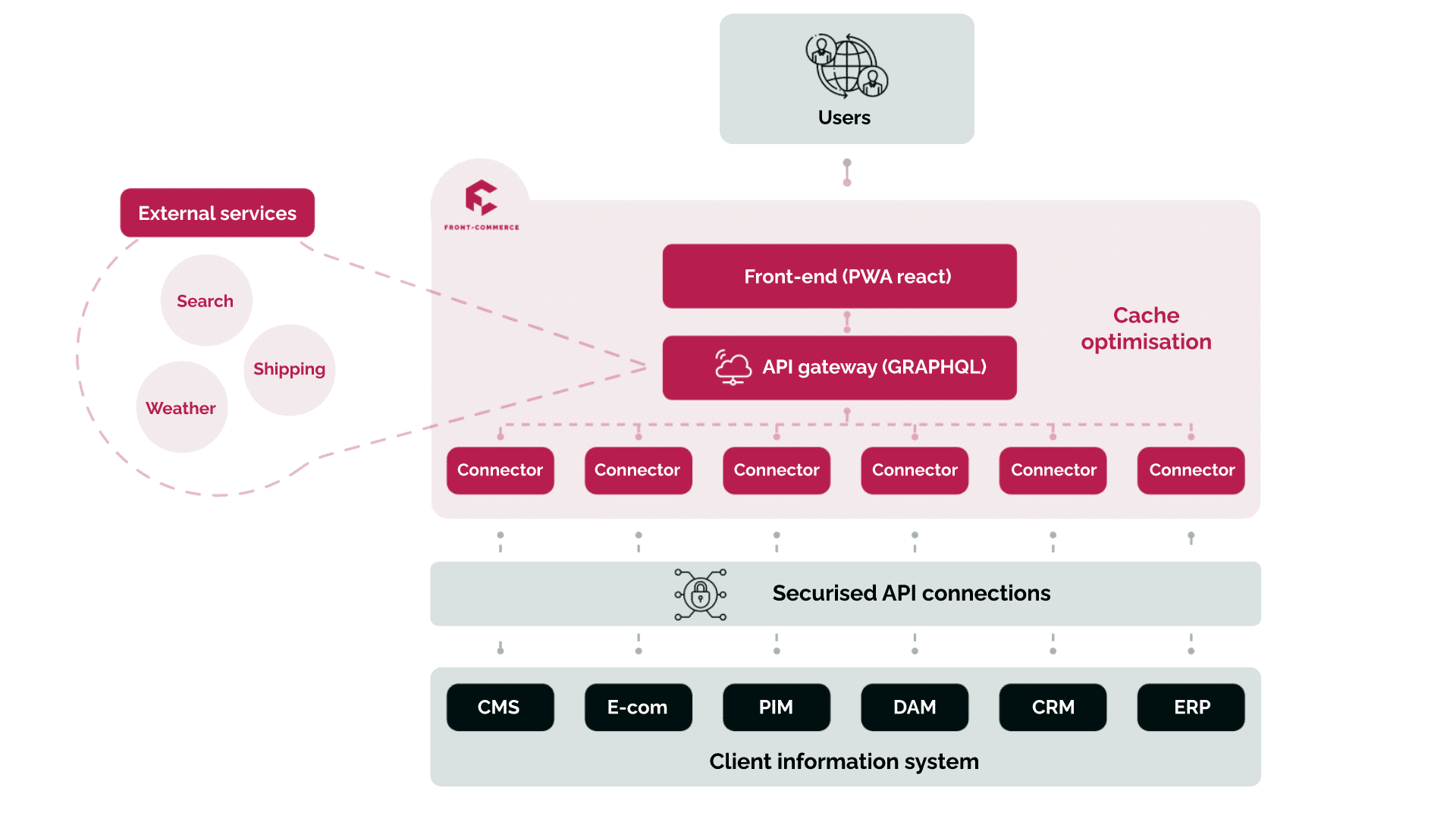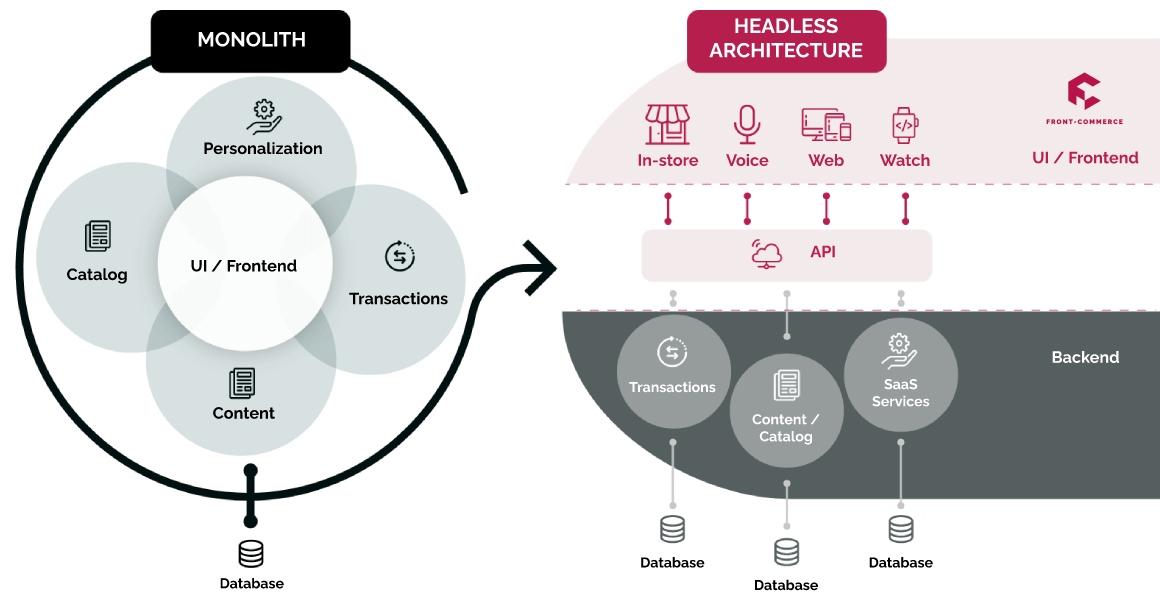Why migrate to a headless commerce architecture?
Amidst the current economic slowdown and an unpredictable environment, customer demands are evolving at an unprecedented pace leaving retailers facing new challenges everyday. In order to keep up with customer expectations, and adapt quickly, brands need to look to digital innovation to improve digital experiences that will in turn increase profitability and ultimately lower business costs.
Keep reading to learn how to migrate from a monolith to headless commerce with our essential steps to a successful migration.
92% of businesses think it’s easier to deliver a powerful digital experience with headless commerce platforms. – WPengine
7 Reasons to Leave your Monolith platform behind:
Monolithic e-commerce platforms are outdated and have unfortunately many limits in terms of agility. Each brick is integrated with one another, making it complicated, costly and time consuming to make changes to the platform.
- Outdated technology
- Continual maintenance
- High total cost of ownership
- Marketing is unable to move quickly
- Scalability is stunted
- Security is questionable
- User experience (especially mobile) cannot be adapted to the modern customer’s needs
Why should your adopt a Headless e-commerce platform?
Whereas, a headless commerce platform is more flexible. The front-end and the backend are decoupled and each e-commerce service is loosely connected via API making it possible for engineers to work on different integrations independently for the foreseeable future.
- Deliver the right experience to customers, developers and merchants
- Say goodbye to future replatforms: adapt to consumer needs without undergoing a complete overhaul
- Control & lower your costs
- Focus on omni-channel experiences & digital performance
- Reduce energy consumption – technologically and in terms of manpower

What is headless commerce?
What does a headless architecture look like?
The different components that make up a headless commerce architecture will typically be organized as in the diagram below. Each block in the diagram represents e-commerce functionality. A merchant can select the best-of-breed components that deliver the most value to their specific case, combining them together effectively to ensure they reach their business goals.

The benefits of a microservices architecture?
7 Important Steps to an e-Commerce Migration Checklist
Moving from a monolithic to a headless e-commerce platform will lead to big savings and incredible growth for your business. But making the move from any existing architecture to a new platform requires careful strategic planning. We’ve outlined the 7 main steps to keep in mind when planning your e-commerce replatform.
Outline business objectives and goals, getting input from all stakeholding services.
Ask your marketing, business development, IT, operations & customer experience departments the following questions:
- What are their pain points?
- What slows them down?
- Are there any pre-existing roadblocks?
- What features must stay?
- What will be the initial build costs?
- What are the predicted ongoing costs, and compared to current costs?
Visualize and map out your ideal e-commerce architecture
Keep in mind the pillars of your platform: users, orders, and products and integration needs. Also not forgetting features and services that you have in place now that must also exist in the new platform.
Risk assessments
- Data migration: map data and integrations that need to be migrated and/or converted.
- Estimate any down time and the consequent impact on traffic & performance
- Content & SEO audit: what’s staying and what’s going
- Hosting and infrastructure needs for integrations APIs
- UX specifications & design
Set priorities & create a roadmap
- What areas of your platform need to be migrated first?
- Are you happy to keep your backend as it is?
- What changes can bring immediate results?
- Can we proceed internally?
Consider a progressive migration as it may be the most adapted option
Development & build
Whether you are developing in-house or not, a timeline will need to be established depending on the key components of your platform.
Migrate data
- What data needs to be migrated?
- Where is the data being stored today and where do you want it stored in the new system?
- When is the right time?
Backup & test for launch
Backup your systems to ensure that no data is lost if something goes wrong during migration and launch. After migration has been completed, test EVERYTHING: integrations function correctly? Any broken links? Missing data?
A “before and after” of migrating to headless commerce

Migrate to a headless commerce architecture
Adapting your monolith architecture to that of headless commerce is essential if you want to keep growing your business today. It will give a business the flexibility it needs to keep innovating and adapting to customer and stakeholder needs.
It is however important to consider the replatform strategically, taking into account your different priorities and technical best practices. Progressive migration makes the move a lot less painful allowing brands to control risks and costs but breaking up the replatform into multiple projects.
Our client, Kaporal, decided to move to headless commerce progressively in 2020. Learn more by reading the use case.
